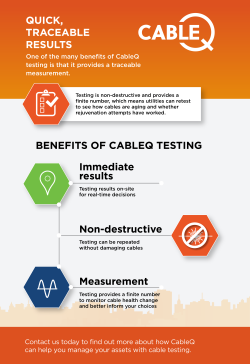XLPE cable infrastructure has been used extensively for more than 40 years world-wide to ensure uninterrupted electricity distribution to urban areas.
The CableQ Solution
XLPE cable infrastructure has been used extensively for more than 40 years world-wide to distribute electricity to urban areas. Our unique and proprietary service is an on-site diagnostic test that measures the depolarization current within an isolated and de-energized cable. The results categorize the cable condition as good, fair, or poor. One of the main aging mechanisms of underground XLPE cables is the development of water trees. Over time, water trees can grow and degrade the quality of the insulation.
CableQ uses a finite health index of 0-100% to assess the condition of medium voltage cable based on the progression of water trees. There has been a consistent correlation between a higher value health index and the length and density of water trees within the insulation. Our method gives an accurate representation of the health of the cable by diagnosing the condition of the insulation.

Quick, Traceable Results
[PDF]
About Water Trees
Water trees are small tree-shaped structures of moisture and ionic impurities that diffuse within the insulation of an XLPE cable and propagate under the effect of an electric field. As water trees grow in length and density, they degrade the quality of the insulation.
Over time, water trees may transform into electrical trees. Electrical tree formation can also develop more rapidly if the cable is subject to high operating voltages. If a cable is operated past its nominal voltage rating for any length of time, the risk of transforming a water tree into an electrical tree is drastically increased. Once the electrical tree is formed, failure is imminent.
Many traditional testing methods use voltages 150% of the cable voltage rating. CableQ’s non-destructive technology uses a maximum of 30% of the cables voltage rating to accurately diagnose the presence of water trees without risking transforming them to electrical trees.
The National Research Council of Canada spent decades researching the effect of water trees on aging cable insulation. Scientists were able to correlate the presence of water trees in cable and its failure rate. This research led to the development of a diagnostic indicator QDep (0-100%) that determine the extent to which water trees are affecting the insulation to an accuracy of 1%, giving you the true condition of your cable.
Veridian
Veridian adopted the Non-Destructive Cable Testing as one of several measures to determine cable health and identify which cables to inject or replace.
